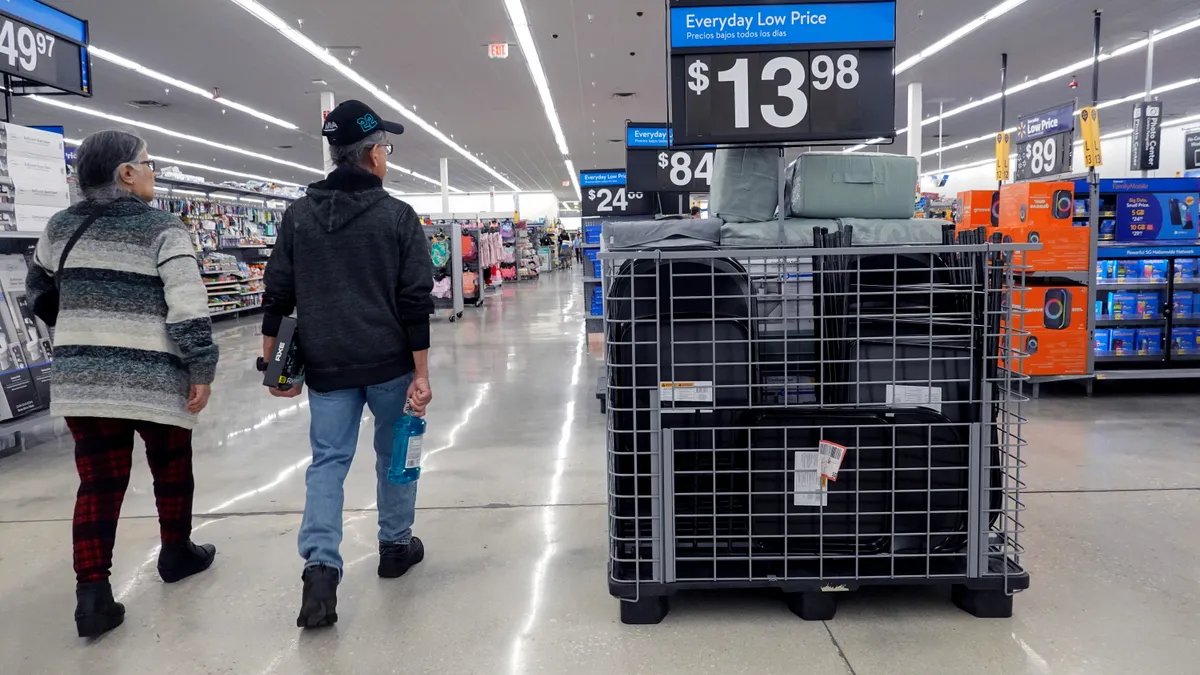Dive Brief:
- Walmart’s efforts to lower prices to meet customer needs and improve its shopping experience are resonating with customers and rewarding the retailer with growth, executives said on a Q1 earnings call Thursday.
- President and CEO Doug McMillon credited store associates for improved customer experience metrics and reiterated plans to invest in associates.
- Walmart reported first-quarter total revenue rose 6% year over year to $161.5 billion, beating analyst expectations. “Profits are growing, customer NPS scores are increasing, and we're running a great operation,” EVP and CFO John David Rainey said on the earnings call.
Dive Insight:
McMillon said Walmart’s consistent focus on value, selection and the shopping experience is resonating with customers.
“We expect to continue to earn healthy levels of sales growth and simultaneously grow profit faster than sales this year while managing our price gaps and investing in our associates at the same time,” McMillon said.
Store remodels and improved pickup and delivery were key to improving the shopping experience.
“Our store remodels look good and are performing well. Plus, our curbside pickup and delivery capabilities are improving as indicated by our customer experience metrics,” McMillon said. “We're making it more convenient to shop with us, and our customers and members are rewarding us with growth as we save them time."
Walmart has completed nearly 70 remodels during the quarter and is on track to do more than 900 this year.
More customers are shopping with Walmart more often and across more categories, Rainey said. Walmart is also focusing on improving perfect orders — a metric for determining if customers can find the products they want via its online store, if the products are in good condition and if they are delivered on time.
“We're laser focused on the things that matter most to our customers,” Rainey said. “Year-over-year in the first quarter, we saw an almost 900 basis point improvement in our perfect order scores. To me that's a great example of how the team is continuing to execute and this is resonating with customers.”
But consumer wallets are still stretched. Rainey said people are opting or needing to spend more on non-discretionary items and less on general merchandise.
“In a tightening consumer economy, Walmart is showing very few signs of fatigue as it churns out yet another strong set of results,” Neil Saunders, GlobalData Managing Director, said in emailed comments.
And higher income consumers are continuing to divert more of their consumables spending to Walmart, according to Saunders. GlobalData found that Walmart has increased its share of households that earn over $100,000 by over 2 percentage points during the last three years. While that reflects broad acceptance of the company’s value proposition, going forward the retailer will need to deepen its relationship with that demographic as inflation drops, which could make further gains challenging, he said.
The retailer’s merchandise mix continues to hinder margins, Rainey said, adding that Walmart U.S. is pursuing strategies to improve general merchandise sales and to increase the visibility of its e-commerce brand assortments in fashion, home and electronics.
Growth across various segments and markets indicate that Walmart “is on a path to drive consistently higher sales and profits,” Jefferies analysts led by Corey Tarlowe said in a Thursday note.
The first-quarter earnings report comes just days after the retailer confirmed it eliminated hundreds of corporate jobs. It also asked “the majority” of its remotely employed associates, along with those in offices in Dallas, Atlanta and Toronto, to relocate. Most will move to the company’s Arkansas corporate headquarters.
Walmart last month also announced it’s closing its U.S. health centers. McMillon on Thursday said “given reimbursement rates and cost to serve, we could no longer see a path to achieving an acceptable level of profitability” for the initiative.













